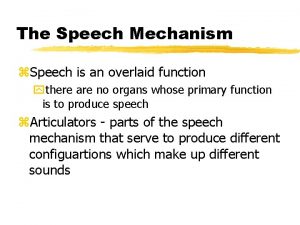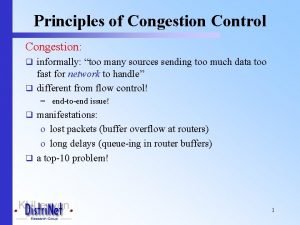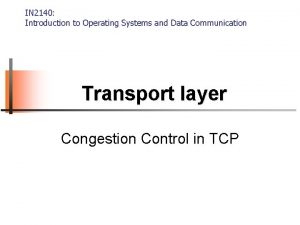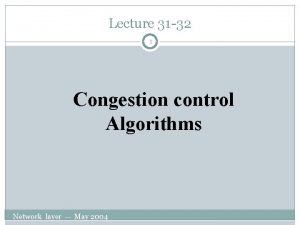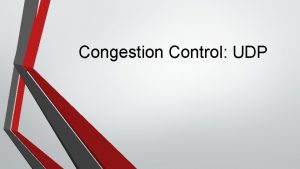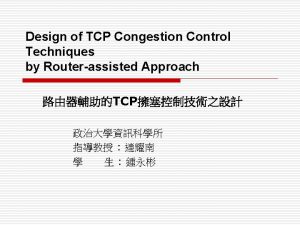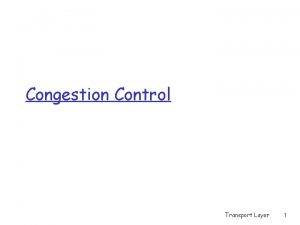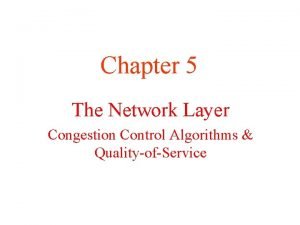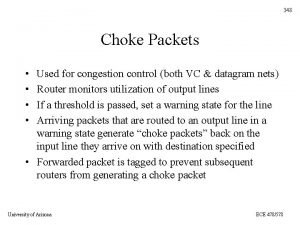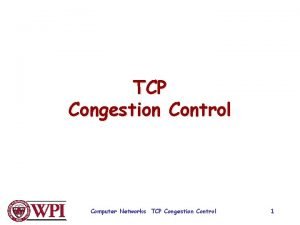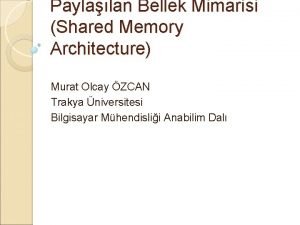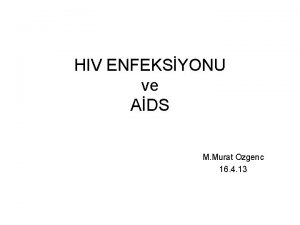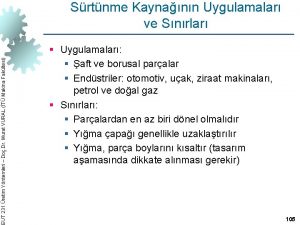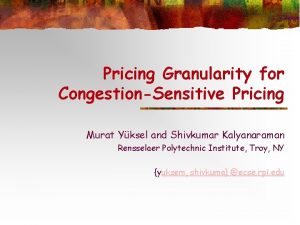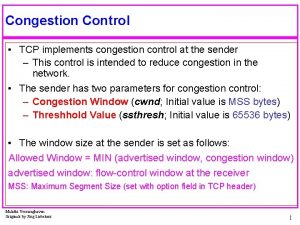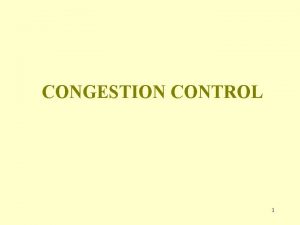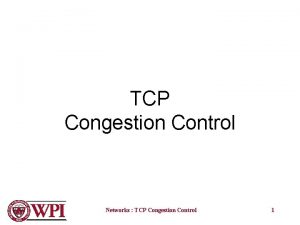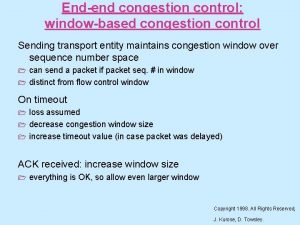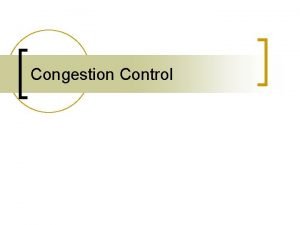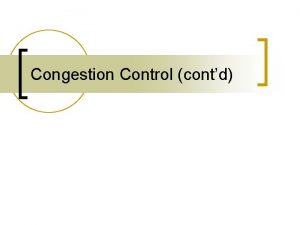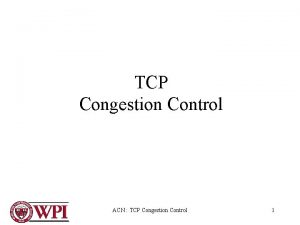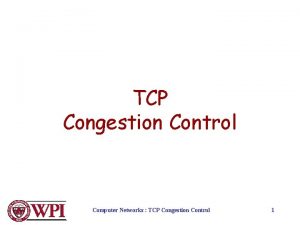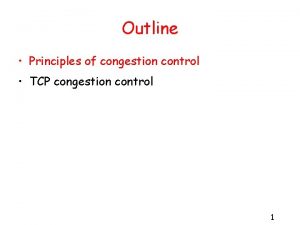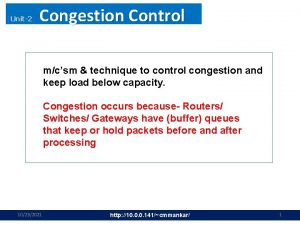Congestion Pricing Overlaid on EdgetoEdge Congestion Control Murat




















- Slides: 20

Congestion Pricing Overlaid on Edge-to-Edge Congestion Control Murat Yuksel, Shivkumar Kalyanaraman and Anuj Goel Rensselaer Polytechnic Institute, Troy, NY {yuksem, shivkuma} @ecse. rpi. edu, goela@rpi. edu

Outline n Literature development : n n n congestion-sensitive pricing DCC -- an edge-to-edge pricing framework Pricing Over Congestion Control (POCC) Edge-to-edge congestion control Simulation experiments Summary

Congestion-Sensitive Pricing n n n Increase the price when congestion, decrease when no congestion. A way of controlling user’s traffic demand hence, a way of controlling network congestion Better resource (bandwidth) allocation Fairness Problems: n n Users don’t like price fluctuations! Each price change must be fed back to the user before it could be applied, i. e. hard to implement in a wide area network.

Traditional Pricing Schemes n n Proposed congestion pricing schemes have used network interior, which is hard to implement Kelly’s, Low’s, Varian’s, etc.

DCC Framework

DCC Framework (cont’d) n n Users negotiate with the provider at ingress points The provider estimates user’s incentives by observing user’s traffic at different prices A simple way of representing user’s incentive is his/her budget Budget estimation:

DCC Framework (cont’d) n The provider offers short-term contracts: n n n is price per unit volume Vmax is maximum volume user can contract for T is contract length Pv is formulated by a “pricing scheme” at the ingress, e. g. Price Discovery [Arora’ 02] Vmax is a parameter to be set by soft admission control

DCC Framework (cont’d) n n No per-packet accounting Updates to edges only Enables congestion pricing by edge-to-edge congestion detection techniques Deployable on diff-serv architecture of the Internet

POCC

POCC (cont’d) n Problems: n n Parameter mapping – need to map parameters of the overlay pricing protocol with the parameters of the underlying edge -to-edge congestion control scheme Edge queues – need to manage the edge queues so that they are bounded

An Example Edge-to-Edge Congestion Control Scheme: Riviera n n n n Accumulation-based congestion control mechanism At the egress nodes, estimates edge-to-edge flow’s accumulation a by monitoring packet delay If a < min_thresh, the edge-to-edge flow is not congested. If a > max_thresh, the edge-to-edge flow is congested. Egress informs ingress about the congestion state, along with an average output rate of the flow. Ingress applies an AIMD-like algorithm with increase parameter and decrease parameter to set sending rate. More is available at: n n D. Harrison, S. Kalyanaraman and S. Ramakrishnan, “Overlay bandwidth services: Basic framework and edge-to-edge closed-loop building block”, Poster in SIGCOMM 2001. Y. Xia, D. Harrison, S. Kalyanaraman, “An Accumulation-based Congestion Control Model”, ICC 2003, NGI 8, Tuesday 15: 30.

POCC (cont’d) n Solutions when Riviera is the underlying edge-to-edge congestion control scheme: n Parameter mapping: Let be the fraction of capacity that must be given to. n Set Riviera’s parameters as: n

POCC (cont’d) n Edge queues: n n Subtract necessary capacity from to drain the edge queue headed on . in order Alternatively (or simultaneously), mark packets at the edge when the edge queue exceeds a threshold. This will indirectly reduce the estimated capacity.

Simulation Experiments n n n Average packet size is 1000 bytes. Propagation delay is 5 ms an all links. The buffer sizes are assumed to be infinite, no drops are allowed. User utility is concave: u(x) = b log(x) Users have a budget b and maximize their surplus by sending at a rate b/p.

Simulation Experiments (cont’d) n n n 3 user flows with budgets 30, 20 and 10 $/Mb respectively for flows 0, 1, 2. Total simulation time is 15, 000 s. At every 5, 000 s, one of the user flows gets active, starting from flow 0 up to 2.

Simulation Experiments (cont’d) Pricing w/o edge-to-edge congestion control POCC

Simulation Experiments (cont’d) Pricing w/o edge-to-edge congestion control POCC

Simulation Experiments (cont’d) POCC

Summary n n Control of congestion requires small timescale price updates Users want less frequent price updates POCC overlays large time-scale pricing on top of small time-scale congestion control Problems: n n n Parameter mapping Edge queues Solutions are proposed

Questions, Ideas? n THANK YOU!
 Pincuegula
Pincuegula Parts of speech mechanism
Parts of speech mechanism Principles of congestion control
Principles of congestion control Tcp congestion control
Tcp congestion control Tcp congestion control
Tcp congestion control Traffic throttling and load shedding
Traffic throttling and load shedding Congestion prevention policies
Congestion prevention policies Principles of congestion control in computer networks
Principles of congestion control in computer networks Congestion control in virtual circuit
Congestion control in virtual circuit Udp congestion control
Udp congestion control Tcp congestion control
Tcp congestion control Principles of congestion control
Principles of congestion control Congestion control in network layer
Congestion control in network layer Choke packets in computer networks
Choke packets in computer networks Tcp header segment
Tcp header segment General principles of congestion control
General principles of congestion control Murat ceyhan ymm
Murat ceyhan ymm Murat olcay özcan
Murat olcay özcan Murat perit çakır
Murat perit çakır Akut retroviral sendrom
Akut retroviral sendrom Prof dr murat vural
Prof dr murat vural

